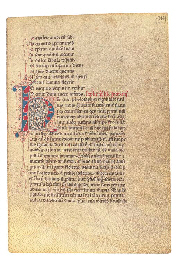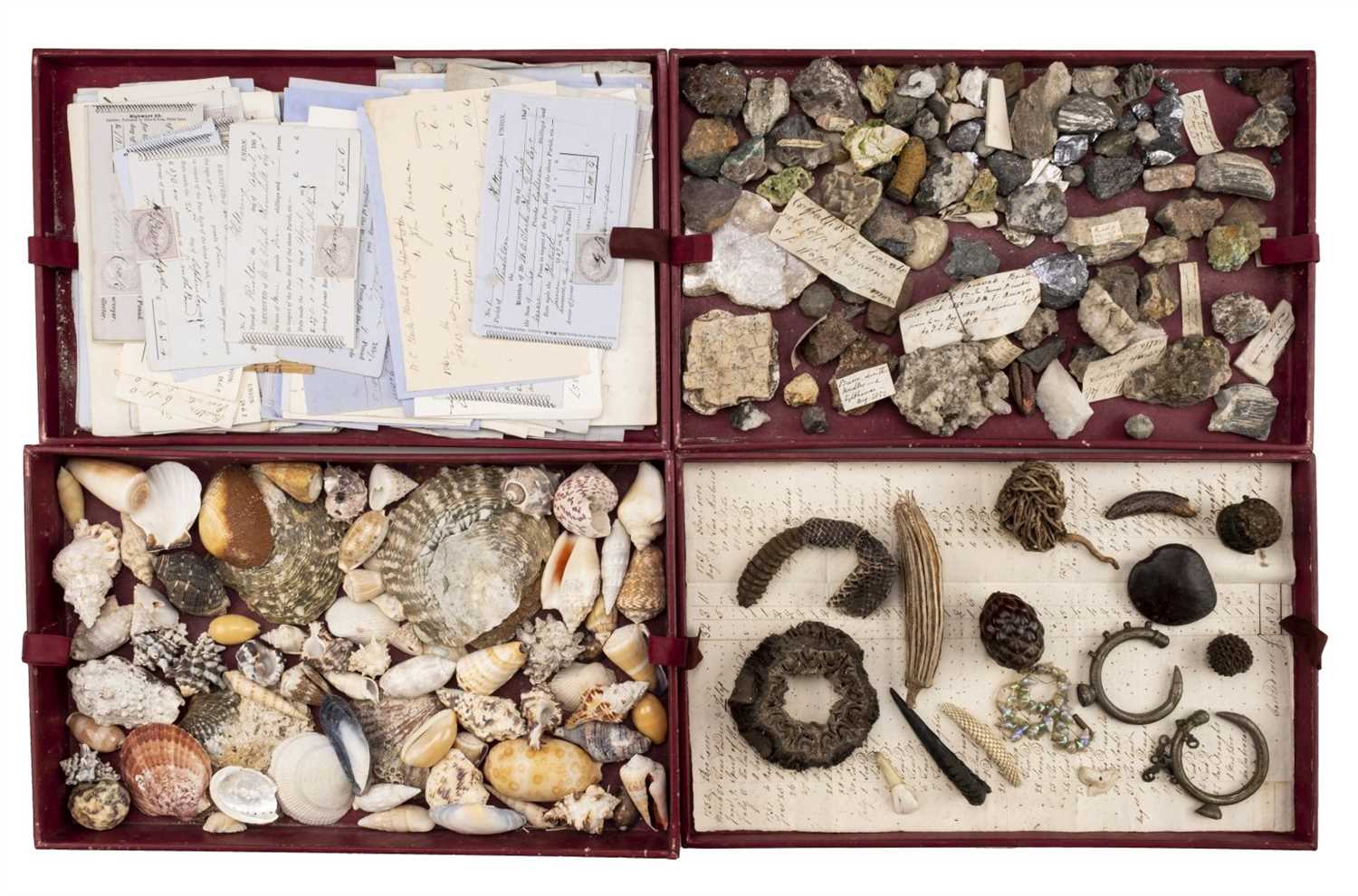WILLIAM OF CONCHES (c.1080-c.1160). De philosophia mundi , in Latin, ILLUSTRATED MANUSCRIPT ON VELLUM [France, second half 12th century] 207 x 147mm. 21 leaves: 1-2 8, 3 5(of 6, v cancelled blank), modern pencilled foliation, two columns of 37 or 38 lines written in brown ink in a small early gothic bookhand within four verticals and on 37 horizontals ruled in blind, prickings visible in the outer margins of most leaves, justification: 172 x 128mm, two- or three-line initials in red, SIXTEEN MAPS AND DIAGRAMS in the ink of the text, contemporary additions or corrections in margins on folios 14 and 18 (natural flaws to several leaves, offset to ff.19v, 20v, 21 from facing script, light stains to ff.10, 18, 19, deletions in ink by an early reader to ff.15v-16, blank lower portion of f.21 trimmed away). Modern vellum; linen box. AN UNRECORDED MANUSCRIPT WITH TWO MAPPAE MUNDI CONTENT: William of Conches, De philosophia mundi ff.1-19v; Hugh of St Victor, Expositio de evangeliis , excerpts added ff.19v-21 De philosophia mundi , probably written c.1130, was the principal work composed by William of Conches and is considered one of the most important 12th-century treatises on natural philosophy. William, who studied with Bernard of Chartres, taught at Chartres in the early 12th century, when the school there was a centre of European intellectual life. Among his pupils was John of Salisbury. William was widely read in the classics and composed commentaries on works of Macrobius, Martianus Capella, Boethius, and the Timaeus of Plato, the principal texts through which the scientific knowledge, and in particular the cosmological knowledge, of Antiquity had been transmitted to the Middle Ages. He was also familiar with the latest scientific and philosophical theories of his day, including those derived from works of Arabic science newly translated into Latin. De philosophia mundi treats astronomy, geography, meteorology and medicine. In discussing astronomy, William provided diagrams to illustrate the orbits of the sun, Mercury and Venus (ff.8v, 9), the zodiac (f.9), eclipses of the sun (f.10v), and eclipses of the moon (f.11). In his discussion of meteorology, he noted that the air becomes less dense and colder as the altitude increases, and he sought to connect the circulation of the air with that of the oceans. His remarks on medicine, which in this manuscript have been partially censored by an early reader, are concerned principally with procreation and childbirth. William's De philosophia mundi was accompanied by two world maps, which, however, were not copied in all subsequent manuscripts of the text. Both are present in this codex. Here the first map (f.13) depicts the world as a circle with east at the top, surrounded and divided into two hemispheres by the ocean. Captions outside the perimeter of the ocean explain the action of the tides. The southern hemisphere is completely empty, but within the northern hemisphere Europe and Africa are indicated, separated by the Mediterranean Sea. Calpe (Gibraltar) and Atlas (the mountains in Africa) are designated, not very accurately. William's second mappa mundi (f.15) is also a circular map with east at the top, and again shows the world surrounded and divided by the ocean. Here, however, the land mass is divided into five zones, a frigid zone at each of the poles, a temperate zone in the central region of each hemisphere, and a torrid zone in the centre divided by the equatorial ocean. In this map the geography of the northern hemisphere is more fully articulated. Asia in the east is divided from Europe by the Tanais and Nile rivers, and Europe is divided from Africa by the Mediterranean Sea. Maps such as these, which show the climatic zones of the earth, are derived from the cosmological sections of Macrobius' Commentary on the Dream of Scipio and Martianus Capella's Marriage of Mercury and Philology . Marcel Destombes, Mappaemondi (Paris 1964) recorded six 12th-century manuscr
WILLIAM OF CONCHES (c.1080-c.1160). De philosophia mundi , in Latin, ILLUSTRATED MANUSCRIPT ON VELLUM [France, second half 12th century] 207 x 147mm. 21 leaves: 1-2 8, 3 5(of 6, v cancelled blank), modern pencilled foliation, two columns of 37 or 38 lines written in brown ink in a small early gothic bookhand within four verticals and on 37 horizontals ruled in blind, prickings visible in the outer margins of most leaves, justification: 172 x 128mm, two- or three-line initials in red, SIXTEEN MAPS AND DIAGRAMS in the ink of the text, contemporary additions or corrections in margins on folios 14 and 18 (natural flaws to several leaves, offset to ff.19v, 20v, 21 from facing script, light stains to ff.10, 18, 19, deletions in ink by an early reader to ff.15v-16, blank lower portion of f.21 trimmed away). Modern vellum; linen box. AN UNRECORDED MANUSCRIPT WITH TWO MAPPAE MUNDI CONTENT: William of Conches, De philosophia mundi ff.1-19v; Hugh of St Victor, Expositio de evangeliis , excerpts added ff.19v-21 De philosophia mundi , probably written c.1130, was the principal work composed by William of Conches and is considered one of the most important 12th-century treatises on natural philosophy. William, who studied with Bernard of Chartres, taught at Chartres in the early 12th century, when the school there was a centre of European intellectual life. Among his pupils was John of Salisbury. William was widely read in the classics and composed commentaries on works of Macrobius, Martianus Capella, Boethius, and the Timaeus of Plato, the principal texts through which the scientific knowledge, and in particular the cosmological knowledge, of Antiquity had been transmitted to the Middle Ages. He was also familiar with the latest scientific and philosophical theories of his day, including those derived from works of Arabic science newly translated into Latin. De philosophia mundi treats astronomy, geography, meteorology and medicine. In discussing astronomy, William provided diagrams to illustrate the orbits of the sun, Mercury and Venus (ff.8v, 9), the zodiac (f.9), eclipses of the sun (f.10v), and eclipses of the moon (f.11). In his discussion of meteorology, he noted that the air becomes less dense and colder as the altitude increases, and he sought to connect the circulation of the air with that of the oceans. His remarks on medicine, which in this manuscript have been partially censored by an early reader, are concerned principally with procreation and childbirth. William's De philosophia mundi was accompanied by two world maps, which, however, were not copied in all subsequent manuscripts of the text. Both are present in this codex. Here the first map (f.13) depicts the world as a circle with east at the top, surrounded and divided into two hemispheres by the ocean. Captions outside the perimeter of the ocean explain the action of the tides. The southern hemisphere is completely empty, but within the northern hemisphere Europe and Africa are indicated, separated by the Mediterranean Sea. Calpe (Gibraltar) and Atlas (the mountains in Africa) are designated, not very accurately. William's second mappa mundi (f.15) is also a circular map with east at the top, and again shows the world surrounded and divided by the ocean. Here, however, the land mass is divided into five zones, a frigid zone at each of the poles, a temperate zone in the central region of each hemisphere, and a torrid zone in the centre divided by the equatorial ocean. In this map the geography of the northern hemisphere is more fully articulated. Asia in the east is divided from Europe by the Tanais and Nile rivers, and Europe is divided from Africa by the Mediterranean Sea. Maps such as these, which show the climatic zones of the earth, are derived from the cosmological sections of Macrobius' Commentary on the Dream of Scipio and Martianus Capella's Marriage of Mercury and Philology . Marcel Destombes, Mappaemondi (Paris 1964) recorded six 12th-century manuscr
.jpg)


.jpg)
.jpg)



Try LotSearch and its premium features for 7 days - without any costs!
Be notified automatically about new items in upcoming auctions.
Create an alert